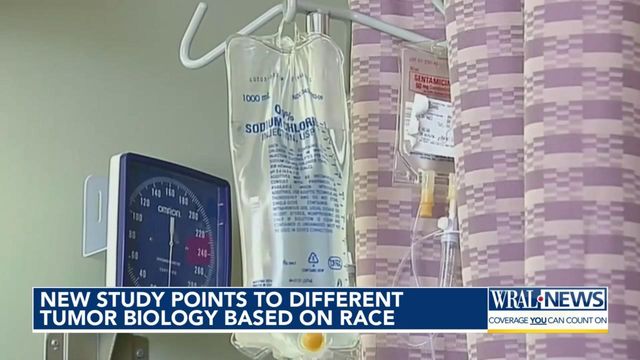New Duke Study finds breast cancer tumors may differ based on race
It’s widely known that racial disparities exist when it comes to cancer survival rates. The question a new study by researchers at the Duke Cancer Institute posed is: why?
In a study published Friday afternoon in the Journal of Clinical Oncology, researchers examined the effects of chemotherapy in triple-negative breast cancer patients.
Triple-negative breast cancer is aggressive and accounts for 15% of all breast cancers, according to the American Cancer Society.
“We define our breast cancer subtypes by the expression of three main markers: estrogen receptor, progesterone receptor and a third protein called HER2,” said Dr. Maggie DiNome with the Duke Cancer Institute. “When you’re negative for all three of those, you’re classified as having triple-negative breast cancer.”
Women under 40 as well as Hispanic and Black women tend to be at higher risk.
DiNome, senior author of the study, explained chemotherapy is widely accepted as the first-step in treatment plans for women after diagnosis. She stated this is because there aren’t any “specific, effective targeted therapies for this kind of breast cancer.”
This made triple-negative breast cancer a good disease to base the study on since treatments follow a similar course of action regardless of ethnicity.
“The purpose of our study was to look and see if there were any differences in response to treatment based on race, because we’ve seen that there’s differences in outcomes in patients,” said DiNome.
The results of the study showed chemotherapy was not as effective across the board.
“It seems that the response to treatment, and then subsequently overall survival, actually varies by race and ethnicity,” DiNome shared.
According to the study, Hispanic women had the best response rate of all with chemotherapy effectively clearing tumors in 33% of patients. Chemo in white women was 31% effective; it was 29% effective for Asian women. Black women had the lowest response rate at 27%.
DiNome explained this could mean the tumors themselves may be biologically different across different races.
“The significance, I think, is that we need to understand a little bit more about the biology of the tumors: what makes them different? And, can this pave the way for future research that allows us to find more effective therapies?” questioned DiNome.
She continued, “All of the clinical trials that led to the development of these regimes of treatment for women with triple-negative breast cancer focused primarily on white women. Minority women were historically underrepresented. A lot of this data comes from those trials so we never really had a way of assessing: 'Does this therapy work the same for all women?'”
DiNome shared she believed breast cancer has “led the way” in terms of standardizing chemotherapy as a first step in treatment plans. It’s why she thinks further studies should be done in other cancers to further explore the idea of different tumor biology based on race.
“Our hope for future research based on the results of our study is to really understand the biological differences that may exist in these cancer subtypes so that we can actually find more effective therapies for women who have this aggressive cancer,” DiNome stated.
She continued, “If our problem is that we’re not able to get that complete response for women and that’s the reason they’re not doing well in terms of survival, we really need to work on finding that effective treatment based on individual patients. One size does not fit all, and we need to move forward in terms of personalized care and personalized medicine and understanding those differences.”
Triple-negative breast cancer is among cancers typically detected in mammograms.
Symptoms may include swelling of the breast, dimpling of the skin, breast pain, changes to the nipple, discharge and swollen lymph nodes.
Annual screenings are recommended for women starting at age 40. Those with known family history of the disease are advised to speak with a doctor as screenings may be recommended sooner. outcome












